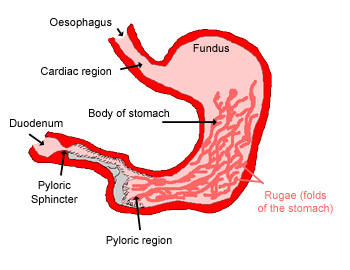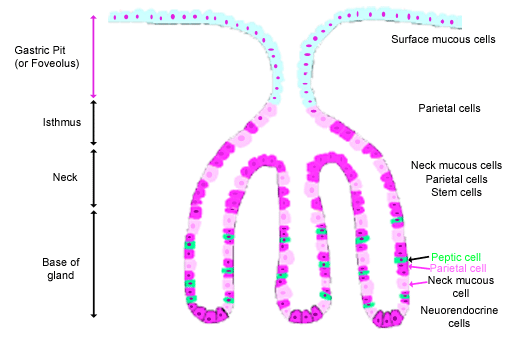Stomach
Structure of the stomach.

Food starts to be digested and absorbed in the stomach, although
absorption is mostly limited to water, alcohol and some drugs.
The stomach is an expandable, muscular bag, and it keeps swallowed
food inside it by contracting the muscular pyloric sphincter.
Food can stay in the stomach for 2 hours or more. Food is broken
down chemically, by gastric juice, and
mechanically, by contraction of the three layers of smooth
muscle in the muscular externa layer. The broken up food
at the end of this process is called chyme.
Gastric juice is secreted by gastric mucosal glands, and contains hydrochloric acid, mucus, and proteolytic enzymes pepsin
(which breaks down proteins), and lipase (which breaks down fats).
When the stomach is empty, and not distended, the lining is thrown up into folds called rugae. After eating, these folds flatten, and the stomach is able to distend greatly.
The stomach has three anatomical regions:
- cardiac, which contains mucous secreting glands (called cardiac glands) and is closest to the oesophagus
- fundus, the body or largest part of the stomach which contain the gastric (fundic) glands
- pyloric, which secretes two types of mucus, and the hormone gastrin.
Compare the glands present in these three regions.
The pyloric region ends at the pyloric sphincter. This sphincter relaxes when the formation of chyme is completed, and the chyme is squirted into the duodenum.
When you've worked through the three regions of the stomach, test your knowledge.
Layers of the stomach.
This shows an image through the wall of the body of the stomach at low power. You should be able to identify the three major layers seen here - the mucosa, submucosa and muscularis externa.
The mucosa is full of gastric glands and pits, and there is a prominent layer of smooth muscle - the muscularis mucosa. The contraction of this muscle helps to expel the contents of the gastric glands.
The muscularis externa layer has three layers of muscle. An innner oblique layer , a middle circular and an external longitudinal layer. The contraction of these muscle layers help to break up the food mechanically.
Now look at this eMicroscope showing the layers.
Toggle labels
This image may also be viewed with the Zoomify viewer.

Oesophageo-gastric junction.
The structure of the oesophagus
was covered in the topic 'oral'. The oesophagus
forms a junction with the stomach, which is called
the oesophageo-gastric junction.
The photograph on the right hand side shows this junction.
Can you identify the oesophageo-gastric junction,
where the oesophagus ends, and the stomach begins? This region
of the stomach is called the 'cardiac' region. How does the mucosa
in this region change?
Gastric Glands in the fundus (body) of the stomach
The epithelium of the mucosa
of the fundus and body of the
stomach forms invaginations called gastric pits.
The lamina propria contains gastric glands,
which open into the bases of the gastric pits.
These glands are responsible for the synthesis and secretion of
the gastric juice.
The lining epithelium of the stomach, and gastric
pits is entirely made up of mucous columnar cells.
These cells produce a thick coating of mucus, that protects the
gastric mucosa from acid and enzymes in the lumen. Even so, these
cells have to be replaced after 4-6 days.

This diagram shows the structure of a gastric gland, a simple tubular gland.
The isthmus and neck contain dividing cells (stem cells) immature cells and maturing neck mucous cells. The mature cells move up to replace the surface mucous cells. These mucous cells are very pale staining.
Parietal (oxyntic) cells are also concentrated in the isthmus region, but also found in the base and neck of the glands. These are large pale staining cells with a central spherical nucleus. Can you identify them in these sections? (They have a 'fried egg' appearance). Parietal cells make hydrochloric acid, and intrinsic factor, which is needed for absorption of vitamin B12 in the terminal ileum.
Chief/Peptic/zymogenic cells are found in the bases of gastric glands. They have a stongly basophilic granular cytoplasm, as they have lots of rER for production of peptin, which is secreted (as precursor pepsinogen), and basally located nuclei.
Neuroendocrine cells in the bases of the glands secrete serotonin and other hormones.
Look at this high power image of the gastric mucosa from the fundus (main body of the stomach) showing the numerous gastric pits. Can you identify Parietal cells and Peptic cells, surface mucous cells, gastric pits, and the base of the pits.
Now take a look at this eMicroscope of the gastric pits and glands in the fundus.
Toggle labels
This image may also be viewed with the Zoomify viewer.


